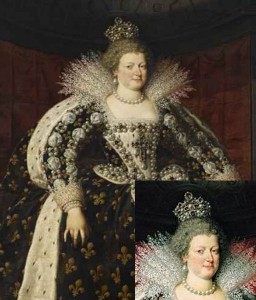One of the marvelous aspects of making jewelry is learning about famous jewelry. It teaches us history, cultural history and some of the most important impulses and beliefs of various civilizations. So when a famous piece of jewelry or historic gemstone changes hands, it’s a good opportunity to refresh our knowledge about the gemstone and its historic context.
Southeby’s announced last week that it will auction the Beau Sancy at its sale of Magnificent Jewels Noble Jewels on May 15.
The Beau Sancy, a modified pear double cut diamond, weighing 3.98 carats, is both magnificent and noble.
In four hundred years, it has been owned by four European families, including some of the names that we on this side of the Atlantic are most familiar with.
The Beau Sancy was acquired in 1570 in Constantinople by Nicolas de Harlay, Lord of Sancy. (Harlay himself led a remarkable life as a diplomat, financier and jewel expert.) Harlay also owned a 55.23-carat shield-shaped yellow diamond called the “Sancy.”
The Beau Sancy probably originated in India near the city of Golconda, the source of many of the best known diamonds in the world, including the Hope, the Koh-i-Noor and the Regent.
Harlay finally sold the larger Sancy to James I of England and legend has it that when Marie de Medici, wife of King Henry IV of France found out about the sale, she was so furious that Henry bought the Beau Sancy to placate her.
Marie had the diamond set in the crown she wore at her coronation on May 13, 1610. (See picture on this page.) The very next day, her husband was assassinated and she was made regent for her eight year old son, Louis XIII.
That exemplar of Mother love was forced into exile by her son seven years later and spent the next twenty five years in intrigue against him. Finally, in 1641, she was forced to sell the Beau Sancy to pay off some of her creditors.
I’m not going to trace its entire history here except to note that the Beau Sancy has been part of the crown jewels of France, Holland, England, Prussia and the German Empire. It belonged to British monarchs William and Mary, reverted to the House of Orange-Nassau, and was sealed in a crypt during WWII where it was found after the war by British troops who restored the diamond to the House of Hohenzollern where it has remained ever since.
Georg Friedrich Ferdinand, Prince of Prussia, head of the Imperial House of Hohenzollern and great-great-grandson of Wilhelm II, the last Kaiser of Germany, is selling the Beau Sancy. Estimates are that the diamond will fetch up to $4 million.
The Beau Sancy has only been shown four times in the last 50 years. Before the sale, the diamond will be shown in Sotheby’s showrooms in Hong Kong, New York, Rome, Paris, London and Zurich before arriving at its destination in Geneva. So, if you’re in one of the neighborhoods, do try to see it.
The larger “Sancy” diamond is owned by the Louvre and there is some hope that the Louvre will buy the smaller stone, reuniting the famous cousins.



